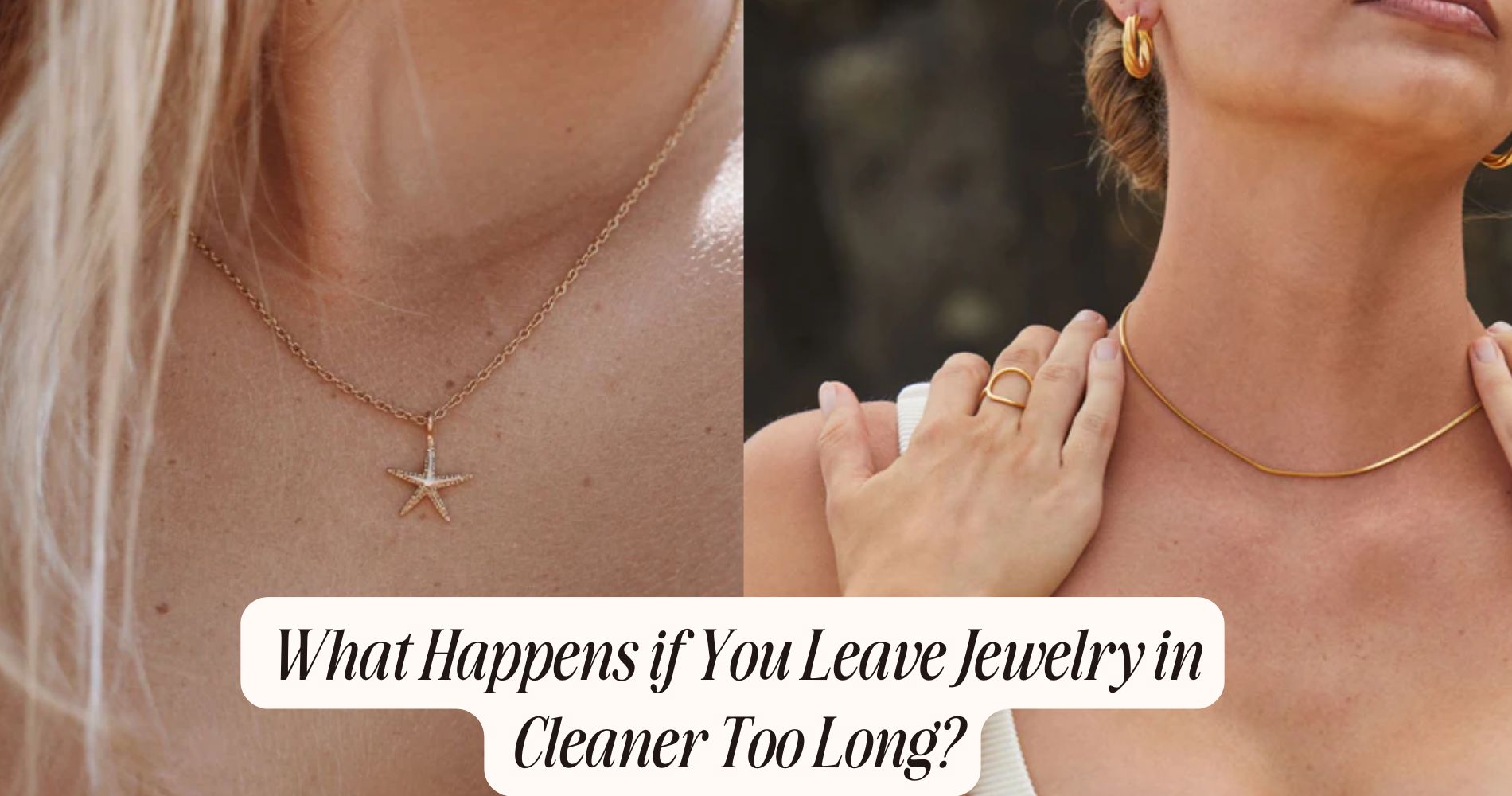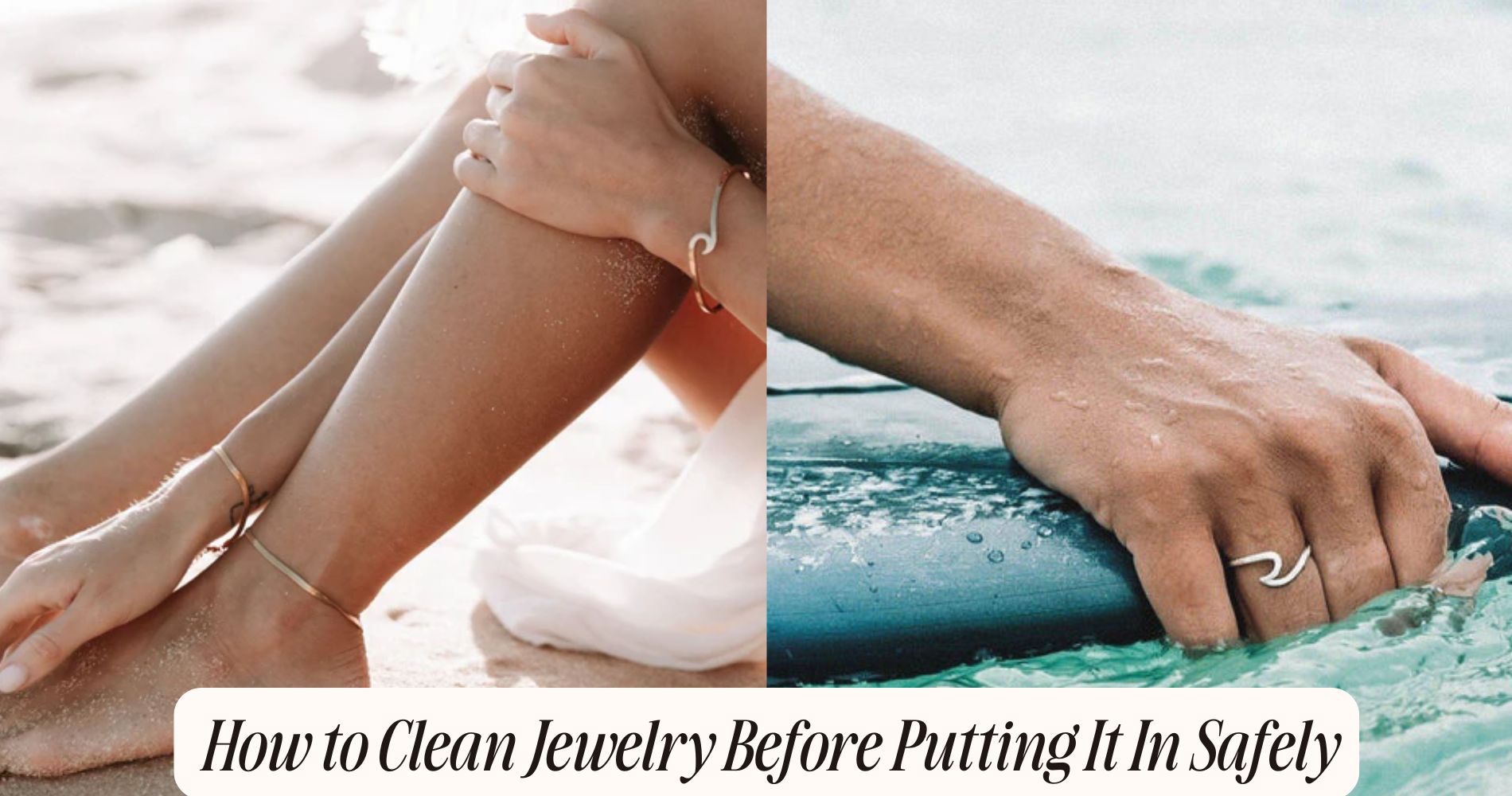
What Happens if You Leave Jewelry in Cleaner Too Long?
What happens if you leave jewelry in cleaner too long? If you leave jewelry in a cleaner too long, you risk serious damage. Metals like silver and gold may suffer from tarnishing, pitting, or structural weakening due to corrosive effects. Gemstones, especially porous ones like opals and pearls, can discolor or become loose as adhesives weaken. Over-soaking also dulls finishes and strips protective coatings, diminishing shine and increasing tarnishing potential. To prevent these issues, always follow the manufacturer's recommendations for soaking times and cleaning methods. Adhering to these guidelines can guarantee your jewelry remains beautiful and intact, avoiding costly restoration or replacement down the line. You might find more insights ahead in our Tarnish-Free Jewelry collection.
Understanding Jewelry Cleaners
When it comes to cleaning your jewelry, understanding the different types of jewelry cleaners available is vital. Each cleaner is designed for specific materials, and knowing which one to use can greatly impact your jewelry care routine.
For instance, ultrasonic cleaners use sound waves to gently remove dirt and grime, making them suitable for sturdy pieces like gold and platinum. However, they may not be safe for porous stones or antique items.
Chemical cleaners, such as solutions containing ammonia or alcohol, can effectively clean metals but may cause damage to certain gemstones. Always read the labels and verify compatibility with your jewelry type.
Cleaning frequency also plays a fundamental role in maintaining your jewelry's appearance. Regular cleaning, ideally every few weeks, prevents buildup and preserves shine.
However, for delicate items, less frequent cleaning may be necessary to avoid wear and tear.
Understanding the right cleaner and the appropriate cleaning frequency will help you maintain your jewelry's beauty without causing damage. Always prioritize the specific needs of your pieces to guarantee they last a lifetime.
Common Types of Jewelry Cleaners
When it comes to cleaning your jewelry, you'll often encounter chemical-based cleaners and ultrasonic jewelry cleaners.
Chemical cleaners use specific formulations to break down dirt and grime, while ultrasonic cleaners employ high-frequency sound waves to agitate a cleaning solution, effectively reaching intricate areas.
Understanding the differences between these methods can help you choose the right cleaner for your precious pieces.
Chemical-Based Cleaners
Chemical-based cleaners are popular choices for maintaining the brilliance of your jewelry. These solutions typically contain ammonia, alcohol, or other solvents that effectively dissolve grime and tarnish.
When using a chemical cleaner, it's vital to take into account the cleaning frequency. Overusing these products can weaken certain materials, especially softer gemstones and metals. Aim for a cleaning routine that balances effectiveness with caution—generally, once every few weeks is sufficient for most jewelry types.
Solution concentration plays a significant role in achieving ideal results. Higher concentrations might seem more effective, but they can also lead to damage if misapplied. Always follow the manufacturer's instructions regarding dilution and application.
For instance, a concentrated solution may require dilution before use to protect your jewelry from potential harm. Additionally, always perform a patch test on a small, inconspicuous area of your jewelry to verify compatibility.
Ultrasonic Jewelry Cleaners
Ultrasonic jewelry cleaners are an effective solution for deep-cleaning a variety of jewelry pieces, utilizing high-frequency sound waves to create tiny bubbles in a cleaning solution. These ultrasonic frequencies generate a process called cavitation, where bubbles rapidly form and collapse.
This action dislodges dirt, grime, and other contaminants from your jewelry, even in hard-to-reach areas.
To use an ultrasonic cleaner, you'll need to fill the tank with an appropriate cleaning solution. Many manufacturers recommend specially formulated cleaning solutions designed for ultrasonic cleaning, as they enhance the cleaning process without harming your jewelry.
Make sure to select a solution compatible with the materials of your jewelry, as some metals and stones may react adversely.
Once you've placed your jewelry in the cleaner's basket, you can set the timer according to the manufacturer's guidelines. Typically, cleaning sessions last anywhere from a few minutes to around 20 minutes, depending on the level of dirt and the type of jewelry.
After cleaning, rinse your pieces thoroughly to remove any residue from the cleaning solution, ensuring a sparkling finish.
Effects of Over-Soaking
When you over-soak your jewelry in cleaning solutions, you risk chemical damage that can weaken metal settings and erode finishes.
Additionally, prolonged exposure can lead to surface deterioration, dulling the shine and luster of your pieces.
It's also essential to take into account how over-soaking might compromise the integrity of gemstones, particularly porous or delicate ones that can absorb harmful substances.
Chemical Damage Risks
Over-soaking jewelry in cleaning solutions can lead to significant chemical damage, particularly if you're using harsh agents or prolonged exposure.
When you leave your items submerged too long, chemical reactions can occur that may compromise the integrity of the materials. For example, solutions containing ammonia or bleach can react adversely with metals like gold and silver, causing pitting or discoloration.
Additionally, if your jewelry contains porous stones or delicate settings, the chemicals can seep into these areas, leading to irreversible damage.
Even seemingly mild solutions can cause issues if left too long, as the cumulative effect of repeated over-soaking can weaken the structural integrity of your pieces.
To maintain your jewelry effectively, always follow the manufacturer's guidelines regarding cleaning solutions and soaking times.
Regular jewelry maintenance practices should include short soaks and immediate rinsing with water to prevent chemical residues from lingering.
By being mindful of the cleaning process, you'll preserve both the beauty and longevity of your jewelry, avoiding the severe consequences that can arise from careless cleaning habits.
Surface Deterioration Effects
Even though cleaning your jewelry is essential for maintaining its luster, excessive soaking can lead to surface deterioration that compromises its overall appearance. When you leave your jewelry in a cleaner for too long, surface wear becomes a significant concern. The prolonged exposure to chemicals can strip away protective coatings or finishes, leading to a dull and lifeless look.
Moreover, oxidation effects can occur, particularly on metals like silver and copper. These oxidation reactions can create a tarnished appearance, which isn't easily reversible and may require professional restoration.
Even high-quality metals can suffer from micro-abrasions due to excessive soaking, which affects the jewelry's finish.
It's not just about the chemical composition of the cleaner; the duration of exposure plays a vital role. The longer your jewelry remains submerged, the greater the chances of these adverse effects.
To preserve your pieces, always adhere to the recommended soaking times and be mindful of the materials involved. Taking these precautions will help maintain the integrity of your jewelry's surface, preventing unsightly deterioration and ensuring it stays beautiful for years to come.
Gemstone Integrity Concerns
Many jewelry enthusiasts underestimate the potential risks associated with over-soaking gemstones in cleaning solutions.
While you might think a longer soak equates to a deeper clean, it can actually compromise the integrity of your gemstones. Many gemstones, such as opals and pearls, have lower durability and can absorb cleaning agents, leading to discoloration or structural damage. Over-soaking can also weaken the adhesive used in gemstone settings, causing stones to loosen or even fall out.
You should be aware that the cleaning frequency matters considerably. Regular, gentle cleaning—using appropriate solutions and methods—helps maintain gemstone durability without risking damage.
For more resilient stones like diamonds and sapphires, the risks are lower, but caution is still advised.
It's vital to follow manufacturer guidelines on cleaning solutions and times. A quick rinse and dry are often sufficient to keep your pieces looking their best.
Risks to Precious Metals
Regularly cleaning precious metals is essential, but it's important to recognize the risks involved. When you leave jewelry in a cleaner too long, you risk damaging the very metal you're trying to restore. Many cleaning solutions contain harsh chemicals that can lead to metal corrosion, particularly in softer metals like silver and gold.
These corrosive agents can infiltrate the surface, weakening the structure and leading to unsightly pitting or discoloration. While tarnish removal is often the goal, overexposure to these chemicals can do more harm than good.
For instance, prolonged contact with ammonia-based cleaners can strip away protective layers, making your jewelry more susceptible to future tarnishing and corrosion. Additionally, some solutions may react negatively with alloy metals, causing unwanted changes in color or texture.
To mitigate these risks, always follow the manufacturer's recommendations for cleaning time and solution type. Regular, short cleanings are preferable to infrequent, extended ones.
Damage to Gemstones
Cleaning jewelry isn't just about preserving precious metals; gemstones also require careful attention to avoid damage. When you leave your gemstones in cleaner for too long, you risk altering their inherent qualities. Many cleaners contain harsh chemicals that can strip away a gemstone's brilliance and vibrancy, leading to significant gemstone color changes. For example, certain cleaners may fade the vibrant hues of colored stones like amethyst or emerald, resulting in a dull appearance.
Furthermore, prolonged exposure to cleaning solutions can cause clarity loss in your gemstones. This occurs as the cleaner penetrates the stone's surface, potentially revealing or worsening existing inclusions and fractures.
For softer gemstones, such as opals or pearls, the risk is even higher, as the cleaner can erode their delicate surfaces or cause them to lose their luster.
To protect your gemstones, always adhere to the recommended cleaning times specified by the manufacturer. If you're unsure, consider using a mild soap and warm water instead. This approach helps maintain both the color and clarity of your gemstones, ensuring they remain as stunning as the day you bought them.
Impact on Antique Jewelry
Maintaining antique jewelry requires a nuanced approach, as improper cleaning methods can irreversibly damage these cherished pieces. Antique restoration is a delicate process that aims to preserve the original integrity and aesthetic of the jewelry.
When you leave antique items in a cleaner for too long, you risk eroding delicate materials, including aged metals and unique gemstones. Many antique pieces feature intricate designs and settings that can weaken under harsh chemicals or extended exposure.
For instance, cleaners that are safe for modern jewelry may corrode the patina on vintage items, leading to a loss of character that can't be restored. You should also be cautious with pearls, ivory, and coral—common materials in antique jewelry—since they can be particularly sensitive to cleaning solutions.
To guarantee effective jewelry preservation, it's best to use gentle cleaning methods specifically designed for antiques. Always test any cleaner on a small, inconspicuous area first, and consider consulting a professional if you're unsure.
Signs of Overexposure
Overexposure to cleaning solutions can manifest in several distinct signs that indicate your antique jewelry is suffering from improper care.
One of the primary overexposure symptoms is discoloration. If you notice a change in the hue of your metal or stones, the cleaning solution may have reacted with the materials. Additionally, you may observe a dull or cloudy finish, which often results from the protective coatings being stripped away.
Another significant sign is the formation of corrosion or pitting, particularly on metals like silver or gold-plated items. This damage occurs when the cleaner penetrates the surface, leading to structural weakness.
You might also find that gemstones have become loose or have lost their luster, indicating that the adhesive or the stone's integrity has been compromised.
Safe Cleaning Practices
To preserve the beauty and integrity of your antique jewelry, it's essential to adopt safe cleaning practices that minimize the risk of damage. Start by choosing the right cleaning solution; opt for one specifically designed for the type of metal and stones in your jewelry. Always read the label and follow the manufacturer's instructions for dilution and application.
When cleaning, use a soft brush or cloth to gently remove dirt and debris. Avoid abrasive materials, as they can scratch delicate surfaces.
Make it a point to rinse your jewelry thoroughly after cleaning to eliminate any residue that could cause tarnishing or irritation.
Establish a routine for maintenance; jewelry maintenance tips suggest cleaning your pieces every few months, depending on how often you wear them. For frequently worn items, consider cleaning them monthly. For those worn less often, cleaning them every six months may suffice.
How to Avoid Mistakes
When cleaning your jewelry, being aware of common pitfalls can save you from costly mistakes. First, establish a proper cleaning frequency. Over-cleaning can damage delicate pieces, while infrequent cleaning allows dirt and grime to accumulate, making future cleaning more challenging. Aim to clean regularly, but adjust based on wear—daily pieces might need weekly attention, while occasional wear can be cleaned monthly.
Next, always follow the manufacturer's instructions for your specific jewelry type. Different materials require different cleaning methods and solutions. Using the wrong cleaner can lead to discoloration or surface damage. Preventive measures are essential; consider removing your jewelry before engaging in activities that can cause exposure to harsh chemicals or physical stress.
Another mistake to avoid is neglecting to rinse thoroughly after cleaning. Residual cleaner can tarnish your jewelry over time, so make sure you rinse well with clean water afterward.
When to Seek Professional Help
Recognizing the right moments to seek professional help can greatly extend the lifespan of your jewelry. If you notice any discoloration, extensive tarnishing, or damage to settings, it's time for a professional assessment. While minor issues can often be handled with at-home cleaning, persistent problems may indicate underlying complications that require specialized attention.
When dealing with intricate jewelry, like those with gemstones or delicate settings, you should also consider reaching out for cleaning expertise. Certain materials, such as pearls or opals, may not respond well to standard cleaners and can easily be damaged. A professional can guarantee that these pieces are cleaned safely without compromising their integrity.
Additionally, if your jewelry has significant sentimental or monetary value, it's wise to consult an expert rather than risk DIY methods that could lead to further damage. Regular inspections by a jeweler can help identify potential issues before they escalate.
Ultimately, trusting a professional for cleaning and maintenance can save you time and money in the long run, guaranteeing your cherished pieces remain beautiful and intact for years to come.
Frequently Asked Questions
Can I Use Household Cleaners on My Jewelry?
You shouldn't use household cleaner types on your jewelry. These cleaners contain harsh chemicals that can damage delicate pieces. Instead, opt for jewelry cleaning methods specifically designed for your materials to maintain their integrity and shine.
How Often Should I Clean My Jewelry?
You should clean your jewelry every few weeks for ideal maintenance. Regular jewelry cleaning frequency helps prevent buildup. Incorporate jewelry maintenance tips, like gentle cleaning solutions and soft cloths, to keep your pieces looking their best.
What Are Safe Temperatures for Jewelry Cleaning?
For jewelry cleaning solutions, maintain temperatures between 70°F and 120°F. Confirm you monitor the ideal cleaning duration to prevent damage, as excessive heat can degrade materials and affect the effectiveness of the cleaning solution.
Are Ultrasonic Cleaners Safe for All Gemstones?
Ultrasonic cleaners can be effective, but they're not safe for all gemstones. You should consider gemstone durability; softer stones like opals or pearls can be damaged, while harder stones like diamonds typically withstand ultrasonic cleaning well.
Can Over-Cleaning Damage Jewelry Finishes?
Yes, over-cleaning can damage jewelry finishes. Different jewelry materials react uniquely to various cleaning methods, and excessive cleaning may strip protective coatings or dull finishes. Always follow guidelines specific to each material to maintain your jewelry's appearance.
Conclusion
To summarize, leaving your jewelry in a cleaner for too long can lead to significant damage, including tarnishing of precious metals and deterioration of gemstones. To preserve your cherished pieces, always follow the manufacturer's instructions and monitor soaking times closely. If you notice any signs of overexposure, such as discoloration or cloudiness, it's best to seek professional help. By adopting safe cleaning practices, you can guarantee your jewelry remains vibrant and intact for years to come.

























Leave a comment
This site is protected by hCaptcha and the hCaptcha Privacy Policy and Terms of Service apply.